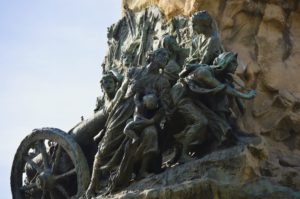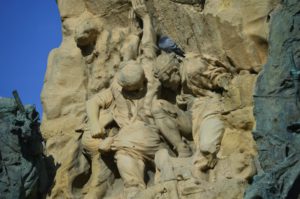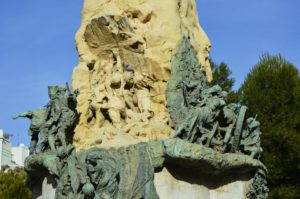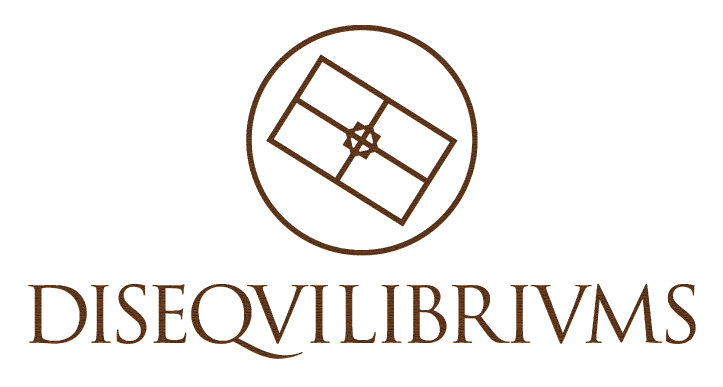DISEQUILIBRIUMS. The Individuals. Chapter 5
CHAPTER 5
Thursday 15 December 2016
Time: 09:00

Erik’s arm has not been on my shoulder for more than five minutes when, in the distance, as we are going down Joaquín Costa Street towards Plaza de los Sitios, we spot the others who we’ve agreed to meet at the entrance of the Provincial Museum.
I detach myself quickly from Erik. This is something that we can’t do. It’s one thing to hold hands among strangers, and another to do it in front of your mates, above all, in front of David, who I’ve known for a long time. In recent months, he’s been behaving a little strangely towards me. I don’t know what’s happened, although I’m not bothered. I’ve too many problems of my own.
Samuel, the fifth member of our group isn’t able to come on the visit we’ve planned for today. He sent me a text message, telling me that he’s at home, down with a fever. What a nuisance! He’s a very special person. In class, not everyone accept him, but I really like working with him. I hope that he can make it for the next visit we organise for the work we’re doing together.
“It’s a strange day!” Erik says in his Swedish accent as we approach.
With their feet up on the seat, Elsa and David are waiting for us on the bench in the plaza where we’ve agreed to meet.
“A typical cierzo day as usual, at this time of year!” David remarks in a hostile tone. I even reproach him with a look.
Erik and I join them on the bench, as I glance at David because of his unfortunate comment.
“Do you know how the History teacher is?” Elsa asks as we sit down.
Nobody answers.
Remembering what happened in class the previous Tuesday is unpleasant. After she began to bleed through her ear, they helped her to a seat. She wiped her face with a handkerchief that the boy with curly hair in the front row had given her. When she checked that she was no longer bleeding, she told us that she was going to put us in teams of five and that each team had to take a sheet from her desk with the instructions she had prepared at home.
No one said a word. We all just stared at her.
“This morning my mother called the school and they told her that she was better, but she was at home.” David surprises us all with his comment.
We were forced to leave the classroom as soon as the bell rang for the next class. As we were leaving, the classmate who had gone to tell the Headteacher had returned, accompanied by the school nurse.
The next thing we learned yesterday from the tutor who was with us was that the teacher had stayed home. He told us that she was dizzy and could not walk, but the doctor who treated her said that it would pass in a couple of days and we would soon have her back in class again.
We were all happy when we heard the news, although I don’t think any of us can easily forget the colour of the blood. The tutor read out her instructions and the make-up of the groups the teacher had given him over the phone so that we could all be organised to start the new project.
“Why has the teacher chosen Samuel to do the project with us?” Elsa asks, David’s response comes immediately:
“Because she likes us.”
That have us all laughing for a bit. He’s back to being Mr Affable, as usual. In truth, the work Miss Barbie has set us does not look like much of a present. On reflection, I decide that with everything that’s happened, it’s probably best to stop calling her that. After the explanation the day before on Cardus, Decumanus and the Roman history of the city, her instructions force us to work in groups of five to prepare a 30-page project. It has to be a well-documented presentation to the rest of the class in only 20 minutes. We have to find out all that we can about the intersection of the Cardus and Decumanus.
She’s succeeded in raising our interest during the lesson, but from there to do a project like that is a totally different matter altogether.
“I have to say,” Elsa starts saying, “that deep down I like this topic. In the beginning, all this talk about a sacred city of ancient Rome sounded stupid, but what she said afterwards got me going. Imagine if this was all true and they really did make it a sacred city.”
“I don’t really believe in this sort of thing,” I remark. “But, at the same time, I have to admit that what attracted my attention the day before yesterday was the geometry.”
I sense a smile on David’s face. However, I don’t think it’s because he thinks my comment is humorous.
“I asked at home last night,” Erik mentions, staring vacantly at the plaza, “and no one in my family knew anything about the Romans or sacred cities. However, my father said he knew about the Cardus and Decumanus. The truth is, I felt kind of strange talking about a sacred city.”
We’re still sitting on the bench in front of the Provincial Museum, waiting for it to open. My dad had brought us to see every monument in the city, but on the two occasions we had come to this one, it was closed. I recall that he told us that it’s an old building in a neo-Renaissance style, built for the 1908 Hispano-French Exposition to commemorate the 100th anniversary of a historical event in the city (the first Siege of Zaragoza). Located at one end of the Plaza de los Sitios where we’re waiting, it’s very well laid-out for visits, according to my father.
The plaza, rectangular in shape, is a space with many trees, children’s games and a monument in the centre. Moreover, with its well-placed benches, you have a good view of everything happening around you.
You can say that the plaza has come alive. Every morning, you can see elderly people taking a stroll in the plaza or enjoying a rest on the benches. In the afternoon, it becomes very lively with mums and dads letting their small children play on the swings; and at the end of the evening, mainly at the weekend, it’s people of our own age taking up various spaces, meeting up to hang out. It’s become the thing to do. Almost every Saturday afternoon, we come here to do something completely different from the reason we are here this morning. If trees could talk, I’d ask them about the many things they could tell us!
As I look at the children’s swings, now empty because it’s a school day, I remember that before the birth of my little sister, my mum used to bring my brother and me to play there.
I have goose bumps thinking about the first time when she taught me how to play on the swings. She and I used to come alone. In the beginning, I thought it was impossible. But, I don’t know whether it was my effort and persistence or my mum’s patience that made me, on that first day, learn to push myself on my own and ‘fly’ in the swing, as we used to say. At the end of that day, I was rising almost above the cross bar. It looked like it was going to go over. It was exciting. My mother looked on at me with pride, unlike other mothers who were shrieking hysterically at their children not to go so high.
I felt powerful, high above everything and everyone.
In particular, because I was such a small girl, I had looked forward to the day when I wouldn’t have to tilt my head so far back to talk to adults. Now, that day has come. I have grown up. I am already a woman. And here I am in the same spot where I had learnt… only years later.
What I remember most about that day is the exact moment when I brought the swing to a stop.
My mum came up to me and gave me a big hug of congratulations, and suddenly, we were spinning around in a whirl.
A few metres behind us, a man applauded us drawing the attention of several parents to us. I remember looking into my mother’s eyes. We were speechless.
“Very good, very good!” the man applauded as he approached the swings.
I imagine that he wasn’t so old but, at that time, I thought that he was over 80. Of average height and white-haired, he was well-wrapped against the winter cold by a type of white cape which revealed baggy, white trousers, under which you could see that he was wearing black boots. What struck me most about him was his face. He had sun-weathered skin, sunken cheeks, and a perfectly clean-shaven face, offsetting his intensely bright blue eyes. This gave him an unusual look. His face appeared full of life. He regarded me gently but, at the same time, there seemed to be a positive force emanating from his eyes. I must have been mesmerised by them because I stared into them for some time without saying anything. When I finally realised how passive I had become, without breaking my gaze, I answered him:
“Thank you!”
He came closer to us, and bending down towards me, he said:
“I was not referring to you, little one.” He pointed to my mother who was watching us and contemplating the moment. “I was referring to her.”
My mum became a little more serious, as if distant, and uncomfortable. She grabbed me, put her arms around me and drew me towards her. I had always liked when I felt protected by her. I loved whenever something like this happened because, on account of her many business trips, the moments we spent together were quite infrequent at the time.
“Forgive me, madam.” The man spoke again, stepping back a little. “I did not want to worry you. But I could not help congratulating you. What I have just witnessed here this afternoon is a great example of perseverance, encouragement and bravery.”
I noticed that my mother had relaxed a little more.
“Thank you,” she began, “I am proud of my daughter.”
“I am sure of it. What is more, she should be proud of her mother because it is you who have communicated those values to her. I wonder who could have transmitted them to you.”
“What do you mean?” asked my mother a little more seriously.
“Look,” he moved from where we were standing towards the statue at the centre of the plaza. “I come here on many an afternoon to meditate on this monument in Los Sitios. The total valour demonstrated by this city’s inhabitants when they confronted the French army in 1808, preventing them from entering the city, received international acclaim for its bravery and perseverance. It was a pity that so many people died, eventually the city had to surrender.”

He turned back to the monument and continued:
“Every citizen fought against their attackers; groups of women came out of their homes brandishing utensils as battle weapons; many men were suddenly and almost seamlessly transformed from farmers to soldiers. The whole episode stands out for its commitment to a common purpose.”
Although I had visited this plaza dozens of times, I had never really given the monument a proper look. Although I was still young, the man’s words made me more interested in it.
“Observe!” He pointed to an area where you could see a woman with a canon. “That is Agustina Zaragoza, on her own, firing the artillery which was cut off when the gunners, who were aiming it, were hit by a shell.”
Until then, I had never heard the story of this woman’s bravery.
He went on describing many events in the battle depicted the monument, covering details that I cannot recall. What the man seemed to be saying was part of the story of war that I wouldn’t normally pay much attention to; but this was something about my city and the way he talked about it so passionately made you feel as if he had been there to witness it all.
“Where do you think she and all the people of Zaragoza got that bravery and strength from?”
He was silent for a moment.
“Your mother,” he turned once more to look at me, “has it and without your realising it, she has passed it on to you.”
As he said it, I felt a shiver pass through me.
It wasn’t just a question. It was something more. There was something mysterious in his words that I didn’t understand at the time, nor even to this day.
My mother abandoned the defensive posture she had at the start of the conversation. I now saw that she too was engrossed by what the old man might say next.
“There is something in this sculpture, which few people have considered and within which lies the true mystery of the image.”
He moved to the right and pointed to the section where you could see some men trying to support something looking like a wall with poles or, you might even say, with their own bodies.
“See, these men died trying to protect the gates against enemy invasion. Specifically, the gates of San Lázaro and Santa Isabel’s convents.”
He looked at each of us in silence for a few seconds, and then continued:
“It was an impossible task as, on the other side, there were horses pushing against them. But there they stood, remaining there to the very last until they were finally crushed. Few people have considered their real reason for protecting those gates, which cost them their lives. Some believe that it was simply because they kept their weapons there…”
He left the sentence unfinished.
Next, holding my mother’s gaze, he added:
“I am sure that someone will be able to discover the truth.”
I remember the moment clearly and I still can’t decide whether it was a challenge or … a command. His tone was serious.
He turned back towards us and, with a smile that I shall never forget, he said:
“The day when all that is depicted in this statue is lost, the city will fall.” He kept silent for a few seconds, observing my mother closely. “Fortunately, little girl,” he said as he turned his head gently towards me, “there are people like your mother.”
I remember that he put something into my mother’s hand. It was small, so small that I could not see what it was when she closed her fist around it. I still can’t understand why he explained all this to me on that day, or the two or three occasions later when I recalled that event.
The man then turned and walked away in the direction towards Zurita Street. He was erect as he walked away with a firm stride. Perhaps it is the mistaken impression of a small girl, but if it were not for the fact that he was an elderly man, I would have sworn that it was the stride of a soldier.

And here I am again, gazing at the same men in the sculpture, trying to hold up that door, at the cost of their lives. Every time I walk through the plaza, I look at those men. What were they trying to protect? What made them do it?
I am roused from my thoughts when Elsa points out that the museum is about to open. Nobody moves. Inadvertently, Erik brushes against my hand. I glance around. As he makes a gesture to apologise, I look him in the eye and smile, furtively caressing his hand with my fingers. For a moment, we remain gazing at each other with our fingers intertwined.
This detail is not lost on David as he watches us.
With a look of disgust, he looks away, gets up from the bench and walks across the street towards the museum.
Suddenly, there’s a cry of pain.
“Oh my God!” David’s shouting.
“What’s wrong?” Erik reacts quickly, immediately moving away from me and rushing towards David.
As we all turn towards David, a few metres in front of us, we see two people lying dazed on the ground, with their hands clutching their ears.
We stare at them, dumbstruck. One is an elegantly dressed elderly lady and the other, a young man, perhaps 20 years old who, I guess, works on the construction site nearby. My eyes scan the entire plaza and, at the entrance of the Provincial Museum, I notice several more people on the ground at different points.
Apart from the lady at the entrance of the church of Santa Engracia while we were walking to the meeting point, there are some young people who, likewise, are sprawled on the grass in the plaza. Near the swings, a tramp is also lying stunned on a bench. I didn’t noticed any of this before. However, in that short period alone, I have already counted at least seven people lying prostrate in various parts of the plaza. The last two figures I can make out on the corner nearest the Red Cross building, near the parked cars, are two men dressed in suits and ties.
However, that isn’t what is so surprising.
What astonishes me is that no one else seems to notice. They walk on by without even looking at the people on the ground.
By this time, the plaza is quite crowded. There is a large group of people going to the Government offices on the corner adjoining the museum.
None of them seem taken aback or, indeed, take the slightest notice of the bodies collapsed on the ground.
Without a murmur, we follow them, walking towards the museum entrance.
For some reason, I glance back at the sculpture in the centre of the plaza, at the heroic figures protecting the gates of the convent.
At that precise moment, the last words of that elderly man, uttered so many years earlier, reverberate in my mind: the city will fall.
Buy the book and support the project:
Writer: Glen Lapson © 2016
English translator: Rose Cartledge
Publisher: Fundacion ECUUP
Project: Disequilibriums
Register on the website www.disequilibriums.com/en/registred and you will receive a notification to allow you to read the chapters as they are published and updates of the project.

No Comments